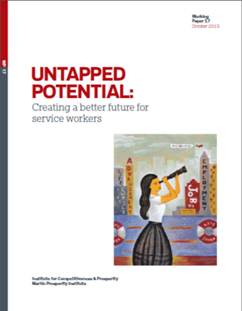

 A rising number of workers in Toronto are employed in temporary, part-time, low-paying positions in routine-service industries, but there is a way forward.
A rising number of workers in Toronto are employed in temporary, part-time, low-paying positions in routine-service industries, but there is a way forward.
Ontario’s economy, and its traditional economic stronghold in the Toronto region, are slowly returning to pre-recessionary levels of employment. Yet there has been growing concern about the kinds of jobs the economy is creating. The growing prevalence of “precarious employment” – jobs that are temporary, part-time, with few benefits and low wages – has been widely discussed in the media in recent months.
In Untapped potential: Creating a better future for service workers, the Institute for Competitiveness & Prosperity partners with the Martin Prosperity Institute to examine job trends within Toronto’s largest employment sector: routine-service jobs. These occupations, including retail staff, food service workers, cleaners, taxi drivers, secretaries, and others, account for 45 percent of Toronto’s workforce and have the worst employment conditions of all occupations. What emerges is a clearer picture of who is being affected, and policy recommendations that can help.
The Problem
• The number of precariously employed routine-service workers – those employed in part-time and/or temporary positions earning at or below the Low Income Cut-Off – in the Toronto region is increasing at a higher rate than the number in non-precarious employment.
• Routine-service workers are less likely to have access to employer-provided benefits, less likely to work a regular 9-to-5 schedule, and more likely to hold multiple jobs.
• Women, youth, and immigrants form the majority of these precariously employed workers.
Cause of the Problem
• The nature of service work is low skill, leading to routine-oriented jobs with low wages.
• The labour market has seen a shift away from permanent, full-time employment toward more temporary, contract, and part-time arrangements. This is influenced by hyper-competition and the need for flexibility amid economic uncertainty.
• Personal characteristics can lead some workers to choose or be forced into precarious employment. For example, mothers with young children are more likely to seek jobs that offer irregular, flexible schedules. Youth and immigrants who lack relevant work experience may only be qualified for service jobs.
Recommendations
• Find new ways of enhancing the creativity content of service jobs through increased certification, better training, and job designs that require more creative input from workers.
• Increase vocational education to help create a dedicated and professionalized routine-service workforce.
• Create tax credits for vocational training programs undertaken by businesses similar to apprenticeship tax incentives.
• Help youth and immigrants better integrate into the labour market and have their skills recognized.
• Prioritize long-term investments in worker retention and view employees as assets. Increase creativity content of jobs. Invest in and reward employee skill and productivity enhancements.
• Extend publicly-funded benefits to workers.
More information can be found in the links below:






